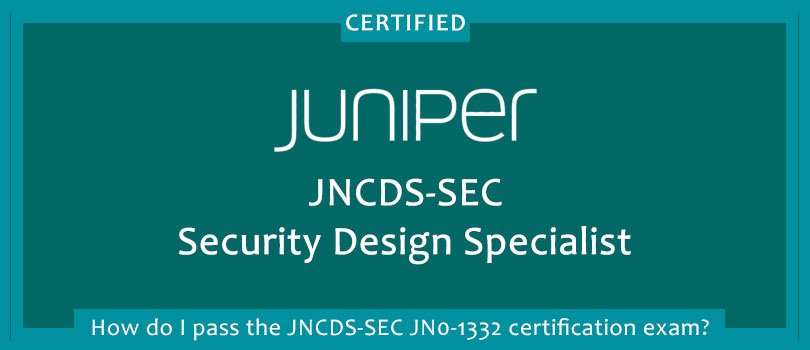
The Security Design Specialist JNCDS-SEC certification exam is one of the expert-level certifications in this field, and how to pass the JNCDS-SEC JN0-1332 certification exam is a question that candidates have to consider.
Your understanding of designing secure networks will determine your score on this exam. So I highly recommend you download the JN0-1332 dumps practice questions to prepare for the Security Design Specialist (JNCDS-SEC JN0-1332) certification exam.
You only need to practice all JN0-1332 dump questions before the JNCDS-SEC JN0-1332 exam certification, and you can guarantee that you can easily pass the Security Design Specialist (JNCDS-SEC JN0-1332) certification exam.
Summary and adoption scheme(JNCDS-SEC JN0-1332):
Vendor: Juniper
Exam Code: JN0-1332 JNCDS-SEC
Exam Name: Security Design Specialist (JNCDS-SEC)
Certification: JNCDS-SEC
Exam Price: $300 USD
Duration: 90 minutes
Number of Questions: 65
Exam Type: Written exam, multiple-choice
Passing score: 70%
JN0-1332 dumps: https://www.leads4pass.com/jn0-1332.html (Premium recommendation)
Read some of the JN0-1332 exam questions and answers:
QUESTION 1:
Click the Exhibit button.

Which type of security solution is shown in this exhibit?
A. service chain model
B. centralized model
C. inline security model
D. de-centralized model
Correct Answer: A
QUESTION 2:
You are designing a DDoS solution for an ISP using BGP FlowSpec. You want to ensure that BGP FlowSpec does not overwhelm the ISP\’s edge routers.
Which two requirements should be included in your design? (Choose two.)
A. Specify a maximum number of BGP FlowSpec prefixes per neighbor
B. Implement a route policy to limit advertised routes to /24 subnets
C. Implement a route policy to limit advertised routes to any public IP space
D. Specify a maximum number of BGP FlowSpec prefixes per device
Correct Answer: CD
Reference: https://www.juniper.net/documentation/en_US/day-one-books/DO_BGP_FLowspec.pdf
QUESTION 3:
You are creating a security design proposal for a customer who is connecting their headquarters to a remote branch site over an unsecured Internet connection. As part of your design, you must recommend a solution to connect these sites together and ensure that the communication is secured and encrypted.
In this scenario, which solution do you recommend?
A. GRE
B. XMPP
C. IPsec
D. MPLS
Correct Answer: C
QUESTION 4:
You are asked to include anti-malware features into an existing network design. Traffic from the infected machines must be moved to a quarantined VLAN.
Which product will provide this segregation?
A. screens
B. Sky ATP
C. unified threat management
D. Software-Defined Secure Network
Correct Answer: B
QUESTION 5:
You want to deploy a VPN that will connect branch locations to the main office. You will eventually add additional branch locations to the topology, and you must avoid additional configuration on the hub when those sites are added.
In this scenario, which VPN solution would you recommend?
A. Site-to-Site VPN
B. Hub-and-Spoke VPN
C. AutoVPN
D. Group VPN
Correct Answer: C
Reference: https://www.juniper.net/assets/us/en/local/pdf/solutionbriefs/3510477-en.pdf
QUESTION 6:
You are deploying Security Director with the logging and reporting functionality for VMs that use SSDs. You expect to have approximately 20,000 events per second of logging into your network.
In this scenario, what is the minimum number of logging and reporting devices that should be used?
A. 2
B. 4
C. 1
D. 3
Correct Answer: C
QUESTION 7:
Which statement about IPsec tunnels is true?
A. They are used to provide in-depth packet inspection for traffic leaving your network
B. They are used to prevent routing loops in a Layer 2 environment
C. They are used to secure and encrypt traffic between tunnel endpoints
D. They are used to combine multiple interfaces into a single bundle
Correct Answer: C
QUESTION 8:
You are designing a corporate WAN using SRX Series devices as a combined firewall and router at each site.
Regarding packet-mode and flow-mode operations in this scenario, which statement is true?
A. Packet mode on SRX Series devices is required for deep packet inspection
B. Packet-mode is only supported on high-end SRX Series devices
C. An SRX Series device in flow-mode cannot forward packet-mode traffic
D. Flow-mode on SRX Series devices is required for security services
Correct Answer: D
QUESTION 9:
You have a campus location with multiple WAN links. You want to specify the primary link used for your VoIP traffic.
In this scenario, which type of WAN load balancing would you use?
A. BGP
B. OSPF
C. FBF
D. ECMP
Correct Answer: C
QUESTION 10:
What are two benefits of the vSRX in a virtualized private or public cloud multitenant environment? (Choose two.)
A. full logical systems capabilities
B. stateful firewall protection at the tenant edge
C. 100GbE interface support
D. OSPFv3 capabilities
Correct Answer: AB
Reference: https://www.juniper.net/documentation/en_US/vsrx/topics/concept/security-vsrx-overview-generic.html
https://www.juniper.net/documentation/en_US/junos/topics/topic-map/logical-systems-overview.html
QUESTION 11:
You are concerned about users attacking the publicly accessible servers in your data center through encrypted channels. You want to block these attacks using your SRX Series devices.
In this scenario, which two features should you use? (Choose two.)
A. Sky ATP
B. IPS
C. SSL forward proxy
D. SSL reverse proxy
Correct Answer: BC
Reference: https://www.juniper.net/documentation/en_US/junos/topics/topic-map/security-user-auth-ssltls.html
QUESTION 12:
You are creating a security design proposal for an enterprise customer. As part of the design, you are implementing 802.1x authentication on your EX Series devices.
In this scenario, which two statements are correct? (Choose two.)
A. The supplicant is the device that prevents the authenticator\’s access until it is authenticated
B. The supplicant is the device that is being authenticated
C. The authenticator is the device that is being authenticated
D. The authenticator is the device that prevents the supplicant\’s access until it is authenticated
Correct Answer: BD
QUESTION 13:
Which two features are used to stop IP spoofing in and out of your network? (Choose two.)
A. GeoIP
B. firewall filters
C. unicast reverse path forwarding
D. IPS
Correct Answer: CD
……
[Google Drive] Download the above JN0-1332 exam questions and answers:https://drive.google.com/file/d/15IYFvXL89qNLSQtwi92Oin7C6ZOqEy3I/
Click to learn more about Security Design Specialist (JNCDS-SEC JN0-1332) certification exam questions.
![[2021] the latest update to Cisco 300-535 dumps and free sharing of exam practice questions from Leads4Pass](https://www.pursue4pass.com/wp-content/themes/instorm/img/thumb-medium.png)
